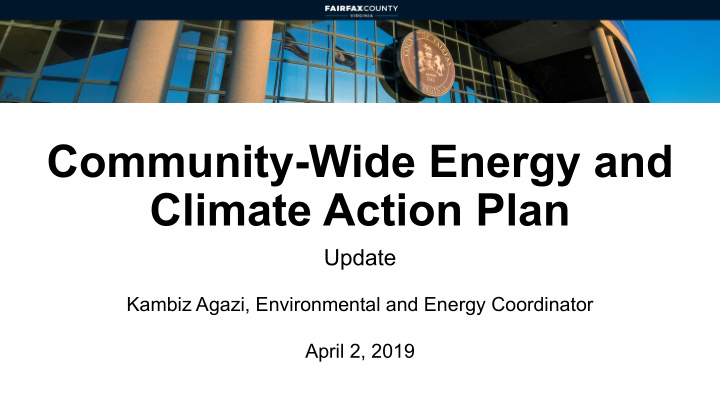



Community-Wide Energy and Climate Action Plan Update Kambiz Agazi, Environmental and Energy Coordinator April 2, 2019
Background • EQAC 2018 Annual Report on the Environment – Climate and Energy Recommendation #1, November 18, 2018 • “EQAC recommends that Fairfax County develop a community -wide energy and climate action plan to reduce GHG emissions in the private sector. Development of this plan should be based on a transparent and collaborative process…” • Board Matter – Fairfax Green Initiatives, February 5, 2019 • Report on “a draft process, resources and timeline to develop a Community - wide Energy and Climate Action Plan (CECAP).” • BOSEC – Request for Information, February 12, 2019 2
What is Energy and Climate Action Planning?
Energy and Climate Action Planning: Comparative Development Overv rview 4
Pre-Requisites to Energy & Cli limate Actio ion Pla lanning • Establishment of responsible office • Proposed Office of Environmental & Energy Coordination (OEEC) designed to support authorized programs, such as Energy Action Fairfax, C-PACE and the solar RFP • Additional programs such as the Energy and Climate Action Plan ( CECAP ) require staff and resources to develop, implement and manage planning • Recognition that actions generally encouraged, not required under current state law • No direct county authority over private sector emissions • County plays a role to encourage private sector transformation • Board approvals on key issues • Funding for consultants and technical advisors • Planning Process • Board endorsement of purpose, goals, objectives, outreach…etc. 5
Energy and Climate Action Planning: Framework and Timeline Phase I – Plan Initiation (~6 -12 months: Summer 2019 – Fall 2020) 1. Mobilize Internal Resources (Recruit staff, contracting services and interns): summer 2019 – winter 2020 2. Develop Planning Process: fall 2019 – spring 2020 3. Build Support from Stakeholders: spring 2020 – summer 2020 4. BOSEC Endorsement of Process: fall 2020 Phase II – Planning (~18 months: estimated Sept. 2020 – Mar. 2021) 1. Assessment of the Current Framework (Where are we?) 2. Establishment of the Vision (Where do we want to go?) 3. Development of the Plan (How do we get there?) 4. Plan Approval 6
Framework and Tim imeline Phase III – Implementation (TBD) 1. Actions Tied to Resource Requirements and Budget Process (Sustainability) • Informed by County Strategic Plan • Support Environmental Vision • Support One Fairfax Policy • Support Economic Success Strategic Plan 2. Multi-Sector (Leave No Major Emitter Behind) • Residential/Commercial • Government/Schools • Utilities/Authorities 3. Multi-Faceted Actions (Navigate the Path with Practical Feet) • Community Engagement and Outreach • Policy Mechanisms for the Residential and Commercial Sectors • County Policy Review and/or Amendments • County Legislative Proposals to VA General Assembly • Sustainable Social or Economic Development Actions 7
OEEC – Proposed Core Services OEEC Advertised Budget • Combination of existing positions and identification of additional requirements • 7 staff / $1,061,060 with a net General Fund impact of $456,137 in FY 2020 • 1 new, 2 existing positions added to Environmental and Energy functions Requirements for Energy and Climate Planning • 2 new positions / $276,749 • Energy and Climate Action Plan contractual support estimated: $0.6 – $1.4 million 8
Energy and Climate Action Planning Team
Recommend
More recommend